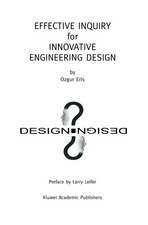Design for Durability and Performance Density
Autor Hani Ali Arafaen Limba Engleză Hardback – 2 oct 2020
Design for Durability and Performance Density includes four real-world case studies which help to identify the root cause of problems and failure cases encountered in industry and in the oil field. It suggests remedies for the ones that could be solved, and includes sample calculations and worked examples to quantify the extent of problems where necessary.
This book will be of use to senior-level mechanical engineering students, design and application engineers as well as consulting engineering firms. It could help them to learn how things could be designed the wrong way, and how old experience could prevent novice mistakes, to avoid being tempted into any of the various subtledesign pitfalls and confronting their consequences.
| Toate formatele și edițiile | Preț | Express |
|---|---|---|
| Paperback (1) | 638.11 lei 6-8 săpt. | |
| Springer International Publishing – 3 oct 2021 | 638.11 lei 6-8 săpt. | |
| Hardback (1) | 893.84 lei 6-8 săpt. | |
| Springer International Publishing – 2 oct 2020 | 893.84 lei 6-8 săpt. |
Preț: 893.84 lei
Preț vechi: 1090.06 lei
-18% Nou
Puncte Express: 1341
Preț estimativ în valută:
171.03€ • 178.57$ • 141.55£
171.03€ • 178.57$ • 141.55£
Carte tipărită la comandă
Livrare economică 04-18 aprilie
Preluare comenzi: 021 569.72.76
Specificații
ISBN-13: 9783030568153
ISBN-10: 3030568156
Ilustrații: XVII, 229 p. 131 illus.
Dimensiuni: 155 x 235 mm
Greutate: 0.53 kg
Ediția:1st ed. 2020
Editura: Springer International Publishing
Colecția Springer
Locul publicării:Cham, Switzerland
ISBN-10: 3030568156
Ilustrații: XVII, 229 p. 131 illus.
Dimensiuni: 155 x 235 mm
Greutate: 0.53 kg
Ediția:1st ed. 2020
Editura: Springer International Publishing
Colecția Springer
Locul publicării:Cham, Switzerland
Cuprins
Introductory Definitions.- Managing Reactive Loads.- Mutually Counteractive Loads at High Speed.- Subtle and Obscure Loading Sources.- Interface Sliding, Loading, and Wear.- Elastic Deformation and Microslip Issues.- Assembly Over Mobile Interfaces.- Proper Allocation of Functions.- Gearing Design for High Power Density.- High Power/Torque-Density Devices.- Hydraulic Power Density.- Megawatt-scale Fluid Power.- Energy Retrieval, Storage, and Release.- Multi-Attribute Designs
Notă biografică
Professor Hani A. Arafa gained his BSc and MSc degrees from Alexandria University in 1962 and 1965 respectively. He gained his doctorate from the University of Stuttgart in 1970. Since then he has worked in numerous academic positions, including his current positions as professor at Cairo University, and adjunct professor at the American University in Cairo. He has written numerous publications in both journals and proceedings, and conducted several consultation activities for industry
Textul de pe ultima copertă
This book is about mechanical design engineering, in particular design for mechanical system durability and performance density. It explains mechanical design issues in application areas such as multi-megawatt fluid power transmission, and provides potential solutions.
Design for Durability and Performance Density includes five real-world case studies which help to identify the root cause of problems and failure cases encountered in industry and in the oil field. It suggests remedies for the ones that could be solved, and includes sample calculations and worked examples to quantify the extent of problems where necessary.
This book will be of use to mechanical engineering students, as well as design and application engineers helping them to learn how things could be designed the wrong way, and how old experience could prevent novice mistakes, to avoid being tempted into any of the various subtle design pitfalls and confronting their consequences.
Design for Durability and Performance Density includes five real-world case studies which help to identify the root cause of problems and failure cases encountered in industry and in the oil field. It suggests remedies for the ones that could be solved, and includes sample calculations and worked examples to quantify the extent of problems where necessary.
This book will be of use to mechanical engineering students, as well as design and application engineers helping them to learn how things could be designed the wrong way, and how old experience could prevent novice mistakes, to avoid being tempted into any of the various subtle design pitfalls and confronting their consequences.
Caracteristici
Explains how to design mechanical systems for durability and performance density Provides real-world case studies to demonstrate errors and their potential solutions Offers practical guidance on how to avoid falling into subtle design pitfalls



























